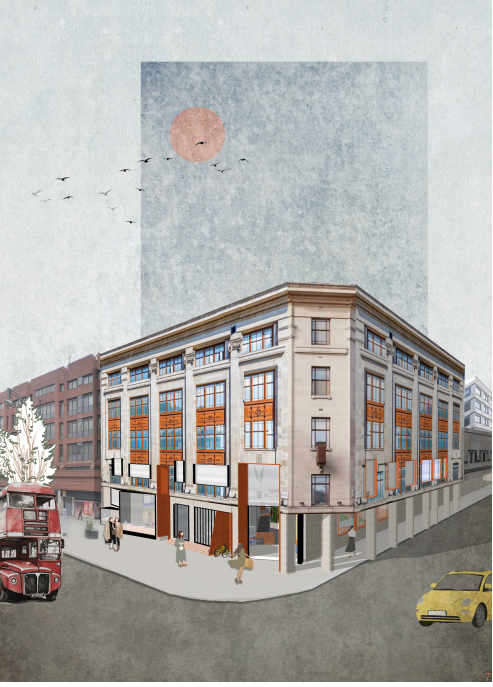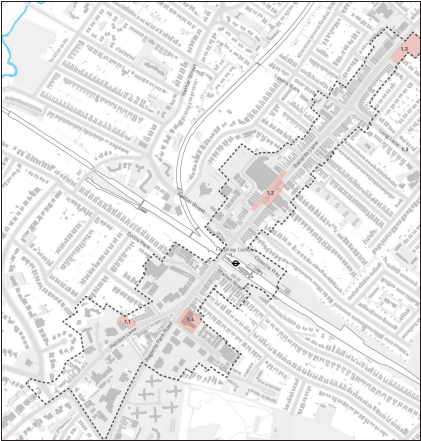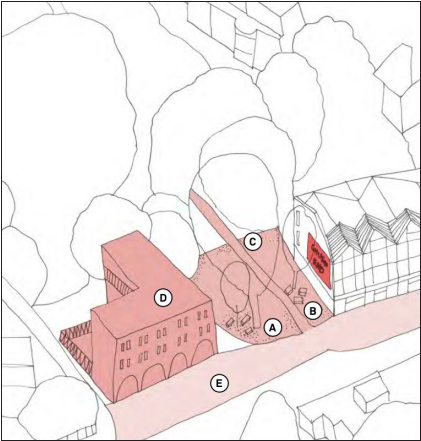| Category | Assignment | Subject | Education |
|---|---|---|---|
| University | Middlesex University London | Module Title | IAD4102 Research and Record |
| Academic Year | 2025/26 |
|---|
Perception . Investigate . Detect . Sustainability Report . Typology . Community . Genius Loci . Test Essence . Amenities . Materiality . Adaptive Reuse History . Archive . News-feed . Identity . Poche Massing . Street-scape . Enfilade . Concept . Gesture Taxonomy . Structure . Hierarchy . Public . the Room Reconnecting . Rethinking . Reworking . Regenerate Sequence . Liminal . Zeitgeist . Adjacencies . Space Interiority/Exteriority . Palimpsest . Superimpose Collate . Presentation . Group work . Sense of Place Program . Research . Agitprop . Design . Iteration Experiment . Dimensions . Enquire . Scale . Context In-betweeness . Marginal . Overlooked . Repurposing Social Empowerment . Explore . Carbon footprint Heritage . Retrofitting . Skin . Anthropocene . Culture Intersection . Flâneur . Deconstruction . Observation Hybrid . Composition . Opacity . Map . Finchley Central
This module is focused on establishing a comprehensive research framework that supports your design practice. You will explore a wide range of tools, including model-making, digital technologies, and visual mapping techniques, alongside investigation into theories, histories, and the cultural contexts that shape the built environment. You will gather, analyse, and record insights related to a specific physical site, transforming this research into a personal direction that informs your design thinking..
You will establish a comprehensive investigative approach to creative practice and methodologies, that explores the critical interrelationship between theory and practice. You will comprehensively survey, analyse, interpret and comment upon the cultural, social and ecological context within which creative practice takes place.
Students will be encouraged to explore, through site analysis, academic texts and case studies many research practices laying the foundation for the production of an academic paper in the IAD4202 module. Students will research complex concepts and ideas in the field of theoretical writing relating to our subject, while capturing a debate which is relevant to the built environment in the 21st Century.
Students are encouraged to choose a subject matter that is relevant and complimentary to their emerging areas of interest in the IAD4101 module. The two modules, although completely separate can inform one another.
Knowledge & Skills
On successful completion of this module, the student will be able to:

To begin with you will be placed into a Collaborative Agency Group. Working within your group each student will visit site, collate documents and assist in the production of information that captures your allocated site in its entirety.
You will also be researching to find a central theme or research question that highlights a topic of academic and practical relevance to our subjects of Interior Design and Interior Architecture. This might be something that you are developing in the IAD4101 module, perhaps when you are making your documentary, or it might be something that comes from an academic paper, tutor presentation or current affairs issue. It might just be something you think about when on your site visit.
The two first semester modules can be seen as hybrid, in that they combine to make something better than they would on their own. You will also be working in a group for some of the early tasks which will help you see things from a different perspective.
To support your start-up project, you will perform a series of 3 continuous site writings. They will be your immediate response to surroundings and your initial thoughts about the spaces you will be designing into. Each writing performed should allow you to capture the essence of what constitutes your chosen area of study. You will write about what you observe in minute detail. Question what you notice and use your writings to construct/ inform your enquiry/ intervention, remembering at every stage to record the hidden, the ignored yet inspirational, elements of each area/ moment you have encountered. You will then reflect upon two of these writings, edit your thinking, how you have engaged/ immersed yourself with each finding.
The third piece of writing will be a collaborative experiment. You will write the first 100 word paragraph, before folding the paper, revealing only the last sentence to pass to the next person in the group. The next person will continue the writing based on what the perceive to be the meaning of the exposed sentence. Once each member of the team has completed the task the writing will be formatted, illustrated and placed in everyone’s final submission.
Buy Custom Answer Of IAD4102 Assignment & Raise Your Grades
Get A Free QuoteAs a Collaborative Agency create a montage of the street-scape/ concourse. The most basic of photomontages is a record of the outside of the buildings, but what if sometimes the imagery reveals interior spaces or something below our normal sight-line. Some elements might be drawn to reveal something hidden or illustrate something imaginative. Beneath each building or space annotate as completely as possible. You can be descriptive in your captions but you may also want to add various other styles of writing- perhaps describing how the space makes you feel. You may zoom in and describe a selection of the fragments and details from in and around the site so that the photomontage jumps in scale. Why have you chosen to select the views you show? What does this tell us about your teams attitude towards Finchley?
As part of the workshop induction each collaborative agency will produce part of a site model. This will then be turned into a 3D block plan of the buildings that comprise the site. Each group must work with the technical tutor team to represent the buildings within their quadrant. Good photographic records of the existing site will help with this process, especially when working out the approximate height of the buildings.

Mapping and recording information.

Extracts from We Made That’s report 2017
A.During a scheduled workshop map out your groups shared interests. Work up the document with graphics and further references.
B.Using Digimaps, Snazzymaps, Council websites and other mapping sources to represent your groups interest in specific topics. Traffic maps already exist, but what about the pollution that car transport causes. Perhaps a map of the smells of the area, observations about pedestrian routes, the heights of the buildings. You should aim to capture a minimum of five sets of data within your maps. Make all your various maps graphically engaging.
Task 5. Case Study
In discussion with your tutors and in direct correlation with your design module, write a 750 word illustrated case study. This case study should ideally be somewhere that you have personally visited in London. The case study should contain academic references that relate to an emerging academic theme and relate to a research question Your case study should show an aspect of a wider theme, one that you have identified through your ongoing research. The case study must have a list of illustrations and a full bibliography. At their best case studies bridge the gap between theory and practice, allowing the reader to understand complex academic thoughts through an example of built form. Think about how your exemplar explains to the reader your depth of knowledge about a theme relevant to your area of study. Typical components of a well written case study are:
-An explanation of the context, what does the study explain and why is this relevant.
-Writing to show your understanding of the key academic concepts via the case study .
-Demonstration of the key features, it’s impact in terms of the main thematic subject and how the case study is a good example of this.
-Minimum of 3 academic quotes from text books you have examined.
-Captioned imagery to include photographs, plans, and diagrams. The captions should reference the main text and allow the reader a better understanding of your stance.
-In text citations and a Bibliography.
Note *: Tasks 1-4 are group-based work. Your submission will be for the entire agency. This work can also be displayed in your individual IAD4101 books.
Task 5 is individual based work and is the starting point for the academic abstract in the second part of the semester
Thinking of Interiors in as an expansive way as possible, identify a research question or proposal and explore this topic by identifying relevant themes, which are then analysed and commented on through the use of case studies.
Literature Review
Once you have identified a subject with your tutor, that you are interested in exploring further, compile a literature review. This is an organized, critical examination of the existing body of knowledge on a particular subject or research question. It should go beyond simply summarizing sources (this is a bibliography); instead, it evaluates, compares, and synthesizes published studies, theories, and arguments to highlight how they connect, where they differ, and what gaps remain. Think of it as a conversation between scholars that you organize, critique, and interpret.
Contextual Studies Research Plan
Based on your Literature Review make a research plan is a way to identify, select, and order the points you want to make in your writing.
It is important that your area of research is focussed on Interiors, however your subject matter can be any part of the contemporary dialogue that informs our profession. Your plan will lead to a second semester paper which should address an understanding of ‘the interior’ in a substantive way, commenting on an aspect of current interior design practice. Your research plan should invite different ways of thinking about one key aspect of interior processes, trends, practices, shifts, concerns or any other area of built environment theory.
The aim of planning is to put down all your ideas and then to sort through them to organise your thinking. Look at where the ideas group together to see if any common themes start emerging, as these might begin to form the paragraphs in your essay. Your Research Plan should include:
-Details of the Introduction to include an overview of the principle theme/subject- your research question/proposal, it’s relevance to Interiors, and a background/history about the subject.
400 words total.
-Compile an initial list of six possible case studies which relate to various aspects of your central subject matter. The case studies you select should robustly illustrate different aspects, or themes, which relate to your main subject. Once you have identified six case studies, you will consult with a tutor to select three which best relate to your central theme.
300 words per case study, 900 total.
Bibliography
Identify the key texts which support your understanding of your academic area of interest. Utilising each of these texts, extract key quotations and demonstrate your emerging understanding of the subject. Use the quotations in your Research Plan.
List of Illustrations
Select three key images per case study and write footnotes for each image. Your illustrations will ideally show more than just views of the spaces you are analysing. Consider what plans, sections, site context, design development models, examples of process and / or historical references might allow your reader to better comprehend the central points of your research proposal.
Critical Analysis
Each of you will be expected to produce a 200 word critical analysis of another student’s work. You should record what you think works well, as well as what they might improve. Respond also on how their work might inspire or influence your own. You will be in pairs for this task. On completion your analysis should be passed to the other student who will write a minimum 50 word response.
Both pieces of completed writing should be displayed in both of your books accompanied by relevant imagery.
Illustrated Reflective Statement
Towards the end of the semester you will produce a 500 minimum word illustrated, reflective statement in response to your work to date. You will be required to tell you reader how it has informed your thinking, unlocked new ideas and what you intend to develop further. To support your text, we would like you to consider the following sub-headings to help construct your statement.
>Title - Retain or refine what you want your project to be called.
>Reflect- Using Auto-ethnographic writing methods describe personal experiences which explore and connect with broader cultural, social, or political contexts.
>UN SDGs How does your work so far relate to the United Nations Sustainable Development Goals? Which SDGs are applicable to your work, what is your understanding of the goals and how might this inform your thoughts over the coming holidays?
>Refocus- Speculate about how your work so far might inform your second semester work
11
(a)Formative assessment scheme
Through open group seminar discussion and presentation
You are required to present an Oral Presentation outlining a research proposal addressing a specific research question which explores critical debates in research and professional practice relevant to your programme of study.
The presentation should include:
The presentation will be delivered alongside other students as part of a group symposium. Timing will be strictly monitored. A presentation that is too long or too short will be frowned upon.
The date of the presentations will be: 28th October, 2025
The Illustrated presentation should use text in a dark colour on a white background, with clearly legible type face (e.g. Arial, Calibri, Helvetica New Roman), in a clear size (e.g. 11 or 12), with 1.5 or double line space. Students will include a Bibliography and an Illustration List.
Please see Cite Them Right Online for help with correct referencing (accessed through MyMDX - Middlesex University London
(or relevant Library Subject Guide for your Programme)
Please include any Dyslexia / Disability SpLD Memo (if you have one) at the front of your assessment submission.
Effective Oral Presentations make full use of appropriate technology to present image and text together, alongside verbal discussion. You are at liberty to pre-record some or all of your presentation if you deem it a suitable mode of presentation for your topic. You must be present in person.
The presentation will be given in English (additional languages may be used, if desired, but please provide very clear English translations for the audience, either as subtitles, or some other format)
A key function of the Oral Presentation is to communicate verbally your ideas to an audience, imagining that not all of whom will be specialists in your specific field, so special care should be taken to define key terms and specialist vocabulary, and to think of the language and visual communication of the ideas.
The presentations will also help us to give you feedback that will support the development of the summative submission.
(b)Summative assessment scheme
Digital Submission in B5 format. The submission should be uploaded as a single PDF. The deadline for submission is Friday 12th December, 2025 by 1 minute to midnight.
Learning materials:
Online reading lists can be accessed from the My Study area of MyMDX. They highlight essential and recommended reading for all modules you are registered on.
12
Order Custom Answers for IAD4102 Assignment
Order Non Plagiarized AssignmentStruggling with your IAD4102 Research and Record Assignment? Our online assignment help is here to assist you! We provide top-notch University Assignment Help and dedicated management assignment help tailored to your needs. Enjoy the peace of mind that comes with 100% human-written assignments, with no AI involvement, guaranteeing A+ results, on-time delivery, and plagiarism-free content. Enjoy affordable, high-quality services designed specifically for UK students aiming for academic excellence!
Hire Assignment Helper Today!
Let's Book Your Work with Our Expert and Get High-Quality Content
